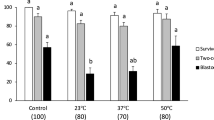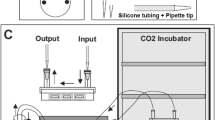Summary
Human embryos after 3–4.5 months of gestation were obtained with abortion. The brain tissue of the bodies was scissored up to obtain 1–3 mm3 pieces, and 7% dymethyl sulfoxide (DMSO), as a cryoprotectant, was added, and then stored at −70°C for 1–30 days or at −196°C for 1–84 days. The survival rate of stored cells was 64%–88%. During 6 days of storage with neuron culture medium, the survival rate of cells at 4°C is over 50% each day, but, as time goes on, the count of the cells is getting less and less. The cells washed out DMSO after cryopreservation and the planting fresh cells can adhere to the wall of the culture bottle, grow, display various forms of neurons and gliacytes. From the above findings, it was suggested that: 1) The fetal human brain tissue, handled properly, can endure cryopreservation with7% DMSO as a cryoprotective agent; 2) The storage time was related insignificantly to the survival rate of the tissues stored; 3)It is available for a short proservation at 4°C and 4) It is possible to set up a bank of fetal human brain tissue.
Similar content being viewed by others
References
Jensen S et al. Cryopreservation of fetal brain tissue later used for intracerebral transplantation. Cryobiology, 1987; 24:120
Houle J D et al. Freezing of embryonic neural tissue and its transplantation in the rat brain. Brain Res, 1980; 192:570
Houle J D et al. Freezing and transplantation of brain tissue in rat. Experientia, 1980; 36:1114
Sφrensen T. Intracephalic transplants of freeze-stored rat hippocampal tissue. J Comp Neurol, 1986; 252: 468
Redmond D E et al. Cryopreservation, culture, and transplantation of human fetal mesencephalic tissue into monkeys. Science, 1988; 242:768
Silani V et al. Human neuronal cell viability demonstrated in culture after cryopreservation. Brain Res, 1988; 473:169
Robbins R J et al. Cryopreservation of human brain tissue. Experimental neurology, 1990; 107:208
Jensen S et al: Intraocular grafts of fresh and freezestored rat hippocampal tissue a comparison of survivability and histological and connective organization. J Comp Neurol, 1984; 227:558
Bjorklund A et al. Intracerebral grafting of neuronal cell suspension I. Introduction and general methods of preparation. Acta physiol Scand, 1983; 522:1
Farrant J. General observations on cell preservation. In: Low Temperature Preservation in Medicine and Biology. MJ Ashwood-Smith and J Farrant eds. Kent: Pitman Medical Limited, 1980; 1–18
Collier T J et al. Intracerebral grafting and culture of cryopreserved primate dopamine neurons. Brain Res, 1987; 436:363
1989; 6:289
Silani V et al. Cryopreservation of human fetal adrenal medullary cells. Brain Res, 1988; 454:383
Author information
Authors and Affiliations
Rights and permissions
About this article
Cite this article
Rong-sheng, C., De-lin, X. & Xian-hui, J. Cryopreservation and culture of the human fetal brain tissues. Journal of Tongji Medical University 13, 138–142 (1993). https://doi.org/10.1007/BF02886504
Received:
Issue Date:
DOI: https://doi.org/10.1007/BF02886504




